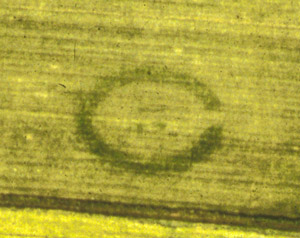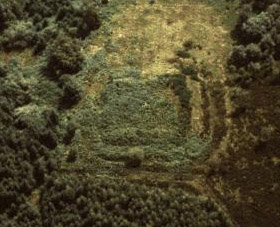In 1845 the minister of Gask in Perthshire wrote that
‘The Roman causeway which extends through
the parish on the highest ground is 20 feet broad, composed of rough stones,
closely laid together …. By the side of this causeway, Roman stations
are visible…. They are enclosed by ditches, which are very distinct’.
This road, which runs along the crest of the Gask Ridge, can still be
traced today, although much of it is overlain by a modern minor road.
Sadly, many of the ‘Roman stations’ have since been ploughed
out, but seven can still be discerned on the ground, and others have been
picked out by aerial photography.

Crop-mark of a watch-tower at Roundlaw,
on the Gask Ridge. The encircling ditch, its entrance facing the Roman
road, is clearly visible. Inside, the four post-holes for the tower's
timber uprights can ba made out.
© Colin Martin
Excavation has shown that these small installations were timber towers about 10 feet (3 m) square, revealed by four deep pits dug for their corner posts. They were set inside a rampart surrounded by a ditch and placed on either side of the Roman road, with their entrances facing it. Distances between them vary somewhat but are nowhere more than a mile, and they were sited to ensure that the ground between each pair of towers was visible from them. The chain of towers thus seems to have been some kind surveillance system, exercising observation and presumably control over movement along or across the line of the road.

Kaimes Castle, a fortlet in the Gask
frontier system
© SCRAN/RCAHMS
Futher towers, together with larger fortlets
which appear to have been part of the same system, have been identified
on the road which runs south-west to Ardoch and beyond, while the chain
seems to extend north-eastwards at least as far as the fort at Bertha,
on the Tay just north of Perth. Together the road, forts, fortlets and
towers seem to represent some kind of frontier, perhaps isolating the
peninsula of Fife from its neighbours to the north and west.
Very little dating evidence has been found on these sites, although they are generally believed to have been constructed in the late first century. If so, they represent the earliest frontier system known in the Roman empire. In the century to follow Rome came to recognise that imperial expansion could not continue for ever. This led to the establishment of frontiers of growing complexity and permanence. The earliest were chains of watch-towers spread along a road, like the Gask system, or following a riverbank, as on the Danube. This process of containment and control led to the evolution of formal frontiers like Hadrian’s Wall and its Antonine successor, and to similar systems on the Continent.

Watch-towers along the Danube, from Trajan's
Column.
© Author's collection
How the Gask Frontier fitted into the framework of Roman activity in Scotland is not known. But it appears to have been short-lived, and to have been deliberately demolished by the Romans. Perhaps it was established in the aftermath of Agricola’s northern campaigns, and abandoned when the legion was withdrawn from Inchtuthil in the late 80s.